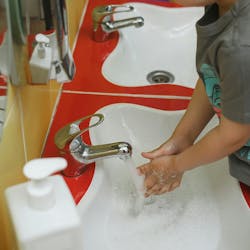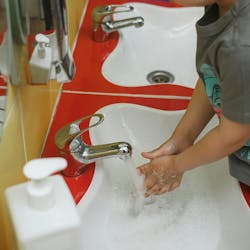Four years ago, with society gripped in fear about the spread of an unfamiliar and potentially deadly virus, frequent handwashing became an important step for protecting the health of everyone, including students.
The Covid-19 pandemic has ended, and concerns about its effects have eased, but the rationale for schools emphasizing frequent handwashing remains: Health care specialists say It is one of the best ways students and staff can protect themselves from contracting an illness.
Adults seem to have kept up their regular handwashing in post-pandemic times, according to the most recent results of The Healthy Handwashing Survey™ conducted by the Bradley Company.
The survey found that 74% of Americans wash their hands more frequently or more thoroughly in response to seasonal virus outbreaks, and 54% increase their handwashing activity when they’re sick. In public washrooms, respondents said they wash their hands 89% of the time.
On the other hand, adults are not so confident that their children are as diligent about their hand hygiene. The survey found that only one in four parents believed that their children do not wash their hands as much as they claim they do. And those adults had good reason to doubt their children's assertions--63% of respondents admitted that they sometimes pretended to wash their hands when they were children.
Those findings make clear the importance of establishing good hand hygiene habits at a young age. The best place to do that is at school.
“It’s important to encourage cleaning hands at key times with soap and water for at least 20 seconds or using an alcohol-based hand sanitizer with at least 60% alcohol if soap and water are not readily available,” says the U.S. Centers for Disease Control and Prevention (CDC).
The CDC provides lots of guidance to help schools incorporate handwashing into the daily routines of students.
- Teach and reinforce handwashing with soap and water for at least 20 seconds. Integrate hand hygiene lessons in K–12 school and ECE program curricula to regularly remind children of the importance of keeping hands clean.
- Build time into daily routines for children and staff to wash hands, especially at key times like after bathroom breaks, before lunch, or after playing outside.
- Supervise and assist children with handwashing as needed. Younger children and children with certain disabilities (such as disabilities that limit their ability to move, or disabilities that make it difficult to follow instructions) may need help with washing their hands.
- Consider making hand sanitizers with at least 60% alcohol available for teachers, staff, and children, especially in areas where soap and water are not readily available (like cafeterias, classrooms, and gyms) and near frequently touched surfaces, such as water fountains, doors, and shared equipment.
- Consider increasing access to hand hygiene infrastructure and supplies, such as sinks, soap dispensers, portable handwashing stations, and hand sanitizer dispensers. It is also important to provide a way for children and staff to dry hands by providing paper towels or hand dryers.-
- Germs spread more easily when hands are wet, so making sure children and staff have a way to dry hands completely can help keep them safe.
One possible handwashing hurdle for schools to overcome is the reluctance of some students to use school washrooms because of social anxieties, fears of being bullied or poorly maintained facilities.
The handwashing survey found that the complaints and concerns of adults about public washrooms mirror those regularly brought up about conditions in school and university washrooms.
Although 43% of respondents said they believed the overall condition of public washrooms is better than it was 15 years ago, 68% of respondents say they’ve had an unpleasant experience because of the condition of washroom facilities.
When asked to share their restroom pet peeves, respondents pointed to used paper towels left on the floor or around the sink (62%), splashed water on countertops and floors (46%) and careless or reckless behavior that damages the facility (41%).
Among the improvements that survey respondents would like to see in public: cleanliness, better stocking of soap and towels and touchless fixtures.
The annual Healthy Handwashing Survey interviewed 1,003 American adults in January about their handwashing habits, concerns about seasonal viruses and their use of public washrooms.
About the Author
Mike Kennedy
Senior Editor
Mike Kennedy has been writing about education for American School & University since 1999. He also has reported on schools and other topics for The Chicago Tribune, The Kansas City Star, The Kansas City Times and City News Bureau of Chicago. He is a graduate of Michigan State University.

